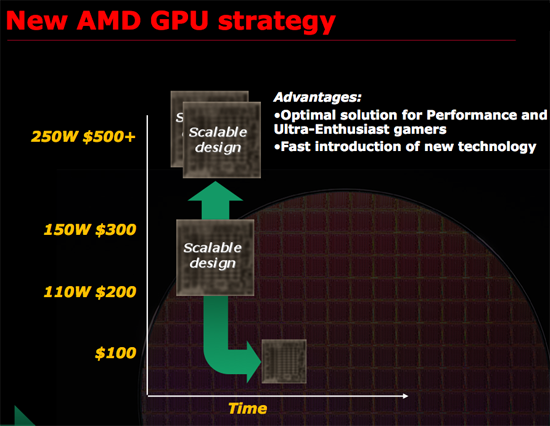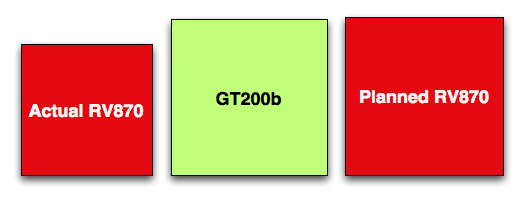The RV870 Story: AMD Showing up to the Fight
by Anand Lal Shimpi on February 14, 2010 12:00 AM EST- Posted in
- GPUs
The Other Train - Building a Huge RV870
While the Radeon HD 5800 series just launched last September, discussions of what the GPUs would be started back in 2006.
Going into the fall of 2007 ATI had a rough outline of what the Evergreen family was going to look like. ATI was pretty well aware of DirectX 11 and Microsoft’s schedule for Windows 7. They didn’t know the exact day it would come out, but ATI knew when to prepare for. This was going to be another one of those market bulges that they had to align themselves with. Evergreen had to be ready by Q3 2009, but what would it look like?
Carrell wanted another RV770. He believed in the design he proposed earlier, he wanted something svelte and affordable. The problem, as I mentioned earlier, was RV770 had no credibility internally. This was 2007, RV770 didn’t hit until a year later and even up to the first day reviews went live there were skeptics within ATI.
Marketing didn’t like the idea of building another RV770. No one in the press liked R600 and ATI was coming under serious fire. It didn’t help that AMD had just acquired ATI and the CPU business was struggling as well. Someone had to start making money. Ultimately, marketing didn’t want to be on the hook two generations in a row for not being at the absolute top.
It’s difficult to put PR spin on why you’re not the fastest, especially in a market that traditionally rewards the kingpin. Marketing didn’t want another RV770, they wanted an NVIDIA killer. At the time, no one knew that the 770 would be an NVIDIA killer. They thought they just needed to build something huge.

AMD's new GPU strategy...but only for the RV770
From August through November 2007, Carrell Killebrew came very close to quitting. The argument to build a huge RV870 because NVIDIA was going to build a huge competitor infuriated him. It was the exact thinking he fought so hard against just a year earlier with the RV770. One sign of a great leader is someone who genuinely believes in himself. Carrell believed his RV770 strategy was right. And everyone else was trying to get him to admit he was wrong, before the RV770 ever saw the light of day.
Even Rick Bergman, a supporter of Carrell’s in the 770 design discussions, agreed that it might make sense to build something a bit more aggressive with 870. It might not be such a bad idea for ATI to pop their heads up every now and then. Surprise NVIDIA with RV670, 770 and then build a huge chip with 870.
While today we know that the smaller die strategy worked, ATI was actually doing the sensible thing by not making another RV770. If you’re already taking a huge risk, is there any sense in taking another one? Or do you hedge your bets? Doing the former is considered juvenile, the latter - levelheaded.
Carrell didn’t buy into it. But his options were limited. He could either quit, or shut up and let the chips fall where they may.

A comparison of die sizes - to scale.
What resulted was sort of a lame compromise. The final PRS was left without a die size spec. Carrell agreed to make the RV870 at least 2x the performance of what they were expecting to get out of the RV770. I call it a lame compromise because engineering took that as a green light to build a big chip. They were ready to build something at least 20mm on a side, probably 22mm after feature creep.










132 Comments
View All Comments
devene - Sunday, February 14, 2010 - link
Just like many others, I've been a long time reader and I just couldn't carry on without leaving a comment:This has been an article, just like the RV770 one. It may not reveal many facts but is tremendously insightful and inspiring. Thank you for bringing this deeply hidden information out to the public and to the "fans". Please do everything in your power to continue this trend.
Once again, thank you Anand,
devene
medi01 - Sunday, February 14, 2010 - link
Germans say "lange Rede kurzer Sinn". So many pointless sentences that do not tell anything even remotely interesting.TGressus - Sunday, February 14, 2010 - link
Even the home team could not be sold on Eyefinity...William Gaatjes - Sunday, February 14, 2010 - link
Fantastic article."
First, it massively increased the confidence level of the engineering team. There’s this whole human nature aspect to everything in life, it comes with being human. Lose confidence and execution sucks, but if you are working towards a realistic set of goals then morale and confidence are both high. The side effect is that a passionate engineer will also work to try and beat those goals.
"
Finally, someone accepting and using human nature.
And see it works out...
The fun part is that a requested functionality that is desired but can not make it within the expected timeframe, can still be worked on and can be ready for the next "bulge" in the market. This way you relieve your engineers form stress, you have the time to sort errors and bugs out, you have time to solve unforseen consequences that always happen( people can get sick, a bug in software, machines breaking down) and you have a feature for the market department to market to the consumer for the next iteration of the product. This way you can use the free market to build an in the end perfect device. It is all about balance. If you have to invest to much energy in situation a, you will have less energy for situation b in a certain timeframe. We are bound by laws of nature meaning there is no "perpetuum mobile" in this universe. Nothing comes for free...
aegisofrime - Sunday, February 14, 2010 - link
Anand, you have taken an article that is really technical in nature, and turned it into something entertaining to read and yet informative for non-engineer types. My hats off to you. This is really the right balance of information and readability. If only all the Scientific Papers I have to read were written like this!dukeariochofchaos - Sunday, February 14, 2010 - link
i wonder if you will give fermi the same drama queen touch?i hope so.
Jamahl - Sunday, February 14, 2010 - link
I don't think anyone wants to read nvidia's marketing department tell us how awesome PhysX and CUDA is again tbh.TGressus - Sunday, February 14, 2010 - link
I suspect Fermi will be able to stand on it's technological innovation.RJohnson - Sunday, February 14, 2010 - link
...and it's exorbitant price/die size will exclude mere mortals from owning one.Spoelie - Sunday, February 14, 2010 - link
That depends entirely on the openness of NVIDIA on the subject, historically not one of their strong points.In fact ATi's take on NVIDIA's design process has been more informative than what has come out of NVIDIA itself.
But here's to hoping..